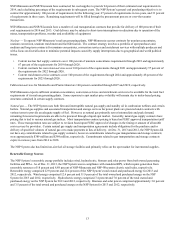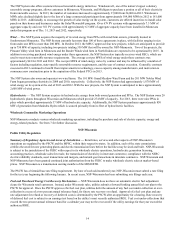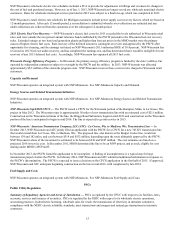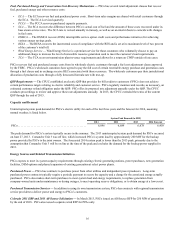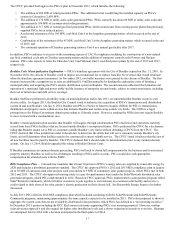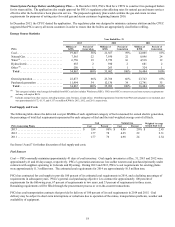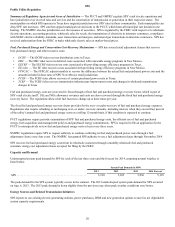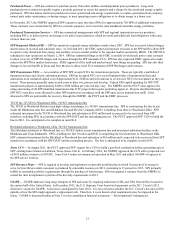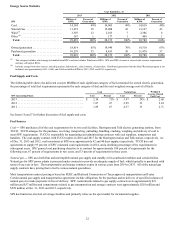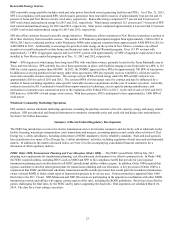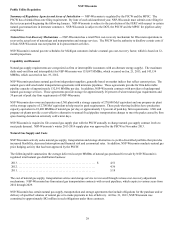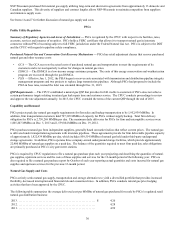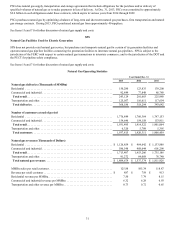Xcel Energy 2013 Annual Report Download - page 39
Download and view the complete annual report
Please find page 39 of the 2013 Xcel Energy annual report below. You can navigate through the pages in the report by either clicking on the pages listed below, or by using the keyword search tool below to find specific information within the annual report.
21
Purchased Power — SPS has contracts to purchase power from other utilities and independent power producers. Long-term
purchased power contracts typically require a periodic payment to secure the capacity and a charge for the associated energy actually
purchased. SPS also makes short-term purchases to meet system load and energy requirements, to replace generation from company-
owned units under maintenance or during outages, to meet operating reserve obligations or to obtain energy at a lower cost.
In November 2013, the NMPRC approved SPS' request to enter into three PPAs for approximately 700 MW of additional wind power.
These contracts were entered into by SPS for economic purposes, not to meet the state mandated renewable energy portfolios.
Purchased Transmission Services — SPS has contractual arrangements with SPP and regional transmission service providers,
including PSCo, to deliver power and energy to its native load customers, which are retail and wholesale load obligations with terms
of more than one year.
SPP Integrated Market (IM) — SPP has operated a regional energy imbalance market since 2007. SPS has recovered related charges
and revenues in its retail and wholesale rates. In 2012 and 2013, the FERC approved proposed revisions to the SPP tariff to allow SPP
to operate a day ahead/real time energy and ancillary services market similar to the regional market operated by MISO. The SPP IM is
scheduled to start operations on March 1, 2014. SPS has submitted filings to the FERC to modify its wholesale power sales contracts
to allow recovery of SPP IM charges and revenues through the SPP wholesale FCA. SPS has also requested FERC approval to make
sales to the SPP IM at market-based rates. FERC approval of the tariff and market based rates filings are pending. SPS has also filed
changes to its retail tariffs in Texas and New Mexico to allow retail FCA treatment of SPP IM charges and revenues.
SPS Transmission NTCs — As a member of SPP, SPS accepts NTCs for transmission projects. These are typically a portfolio of
transmission lines and electric substation projects. SPS has accepted NTCs for several hundred miles of transmission lines and
substations at an estimated capital cost of approximately $1.4 billion and will continue to review new NTCs for acceptance as they are
issued. These projects generally span several years to plan, site, procure and develop. Typical SPS capital spending for SPP NTC
transmission projects is approximately $200 to $300 million per year, but may vary. The NMPRC and the PUCT must approve the
siting and routing of all SPP identified transmission line NTC projects that require permitting approval. Projects identified through
SPP NTCs may have costs allocated to other SPP members in accordance with the SPP open access transmission tariff. Costs
allocated to SPS are permissible for recovery through the NMPRC, the PUCT and the FERC processes.
TUCO Inc. (TUCO) to Woodward, Okla. 345 KV transmission line
The TUCO to Woodward District extra high voltage interchange is a 345 KV transmission line. SPS is constructing the line to just
inside the Oklahoma state line, and Oklahoma Gas and Electric Company (OGE) is building from there to Woodward, Okla. SPS’
estimated investment in the TUCO to Woodward line and substation is $185 million and is expected to be recovered from SPP
members, including SPS, in accordance with the SPP OATT and the ratemaking process. The PUCT approved SPS’ CCN to build the
line in 2012. It is anticipated to be complete in mid-2014.
Hitchland substation to Woodward, Okla. 345 KV transmission line
The Hitchland substation to Woodward line is a 345 KV double circuit transmission line and associated substation facilities in the
Oklahoma and Texas Panhandle. SPS is building the first 30 miles and OGE is completing the line from there to Woodward, Okla.
SPS’ estimated investment for the Hitchland to Woodward line and substation is $63 million and is expected to be recovered from SPP
members in accordance with the SPP OATT and the ratemaking process. The line is anticipated to be complete in mid-2014.
Jones CCN — In August 2011, the PUCT approved SPS’ request for a CCN to build a gas-fired combustion turbine generating unit at
SPS’ existing Jones Station in Lubbock, Texas (Jones Unit 4). In February 2012, the NMPRC approved the CCN with a projected cost
of $118 million, inclusive of AFUDC. Jones Unit 4 achieved commercial operation in May 2013 and added 168 MW of capacity to
the SPS service territory.
SPS Resource Plans — SPS is required to develop and implement a renewable portfolio plan in which 10 percent of its energy to
serve its New Mexico retail customers is produced by renewable resources in 2011, increasing to 15 percent in 2015. SPS primarily
fulfills its renewable portfolio requirements through the purchase of wind energy. SPS was granted a variance from the NMPRC to
extend the time to implement a portion of the diversity requirements to 2015.
CSAPR — CSAPR addresses long range transport of PM and ozone by requiring reductions in SO2 and NOx from utilities located in
the eastern half of the United States. In December 2013, the U.S. Supreme Court heard oral arguments on the D.C. Circuit’s 2012
decision to vacate the CSAPR. A decision is anticipated by June 2014. It is not yet known whether the D.C. Circuit’s decision will be
upheld, or how the EPA might approach a replacement rule. Therefore, it is not known what requirements may be imposed in the
future. CSAPR is discussed further at Note 13 to the consolidated financial statements — Environmental Contingencies.




